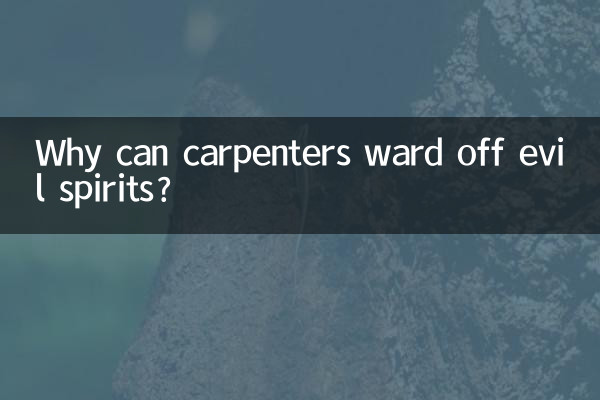Why carpenters can ward off evil spirits: An interpretation from traditional folk customs to modern hot debates
Recently, the topic of "carpenters to ward off evil spirits" has aroused heated discussions on social media and traditional culture forums. This phenomenon not only reflects people's renewed attention to traditional skills, but also reflects the unique vitality of folk culture in modern society. This article will combine the hot data from the entire Internet in the past 10 days to analyze the relationship between carpenters and evil spirits from three dimensions: historical origins, cultural symbols, and modern applications.
1. Data tracking of hot topics across the entire network (last 10 days)

| Platform | Related topics | amount of discussion | core ideas |
|---|---|---|---|
| #The mysterious power of traditional craftsmen# | 128,000 | Carpenter's tools are given the function of building a house | |
| Douyin | "Luban Ruler Measuring Good and Bad" Challenge | 520 million views | The cultural renaissance of traditional measuring tools |
| Zhihu | "Why do they say that carpenters can suppress ghosts?" | 3400+ answers | Discussing craftsmen's beliefs from the taboos in "The Book of Lu Ban" |
| Station B | Documentary "China Mysterious Career Examination" | 983,000 plays | Analyze the special status of the craftsman industry |
2. The historical and cultural origins of carpenters’ ability to ward off evil spirits
1.tool symbolism: The carpenter's ink fountain, square and other tools are regarded as "normal tools" in folk customs, and their straight lines and right angles are considered to have the geometric power to destroy evil spirits. The ancient book "Customs and Meanings" records: "A curved ruler measures the heaven and earth, and an ink line divides yin and yang."
2.Industry worship says: As the founder of the construction industry, Lu Ban was deified as the "Sage of Works", and his legendary "Book of Lu Ban" contains a large number of talismans. The "Tiangong Kaiwu" of the Ming Dynasty specifically records the particularity of the carpenter's house-building ceremony.
3.The theory of the mutual restraint of the five elements: In the five-element system, wood overcomes earth (grave soil belongs to yin), and wood itself has "life", which is in opposition to "death". This concept is clearly stated in "Huangdi Zhai Jing".
3. Cultural continuity from a modern perspective
| Expression | Specific cases | social function |
|---|---|---|
| architectural customs | Talismans in the Liang Liang Ceremony | Psychological soothing effect |
| Cultural and creative products | Mini Luban ruler pendant | transformation of cultural symbols |
| Film and television themes | "Ghost Blows Out the Lamp" Carpenter's Props | Create a sense of mystery |
4. Scientific explanation and folk psychology
1.Sound wave exorcism theory: The specific frequency sound waves produced by the hammering of the ax and chisel have been experimentally proven to relieve anxiety. This coincides with the traditional saying of "sounding instruments to calm the house".
2.order construction theory: Anthropologists point out that by creating regular spaces, carpenters essentially establish order in chaos. This ability is mystified as "exorcism."
3.Professional prestige transformation: Ancient craftsmen mastered key technologies, and their social status derived spiritual authority, forming the dual attributes of "technology and mystery".
Conclusion:From TikTok challenges to academic discussions, the continued rise of the topic of carpenters warding off evil spirits is not only a rediscovery of intangible cultural heritage, but also reflects people's deep yearning for "craftsman spirit" in the technological age. This cultural memory that spans thousands of years is continuing its vitality in new forms.

check the details

check the details